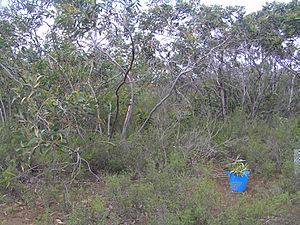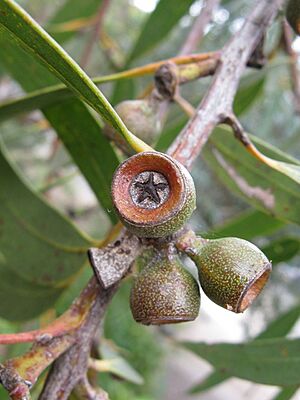Green mallee ash facts for kids
Quick facts for kids Green mallee ash |
|
|---|---|
 |
|
| E. langleyi habit | |
| Conservation status | |
| Scientific classification | |
| Genus: |
Eucalyptus
|
| Species: |
langleyi
|
Eucalyptus langleyi, often called the green mallee ash or albatross mallee, is a special type of mallee tree. It is found only in a small area of New South Wales, Australia. This plant has mostly smooth, grey to yellowish bark. It also has long, curved leaves, flower buds that grow in groups of seven, white flowers, and cup-shaped fruits.
Contents
What it Looks Like
Eucalyptus langleyi is a mallee, which means it's a type of Eucalyptus that grows like a large shrub with many stems. It usually grows to be about 5 to 6 meters tall. It has a special woody lump at its base called a lignotuber. This helps the plant regrow after things like bushfires.
The bark on this mallee is smooth. It can be grey, green, or pink, and it often peels off in long strips.
Leaves, Flowers, and Fruit
Young plants and new shoots have stems that are somewhat square. Their leaves are long and narrow, about 9 to 14 cm long and 2 to 5.5 cm wide. These leaves grow in opposite pairs.
As the plant gets older, its leaves change. Adult leaves are shiny green on both sides. They are broadly lance-shaped or curved, about 8 to 16.5 cm long and 1.8 to 5 cm wide. Each leaf has a small stalk called a petiole, which is about 1 to 2.3 cm long.
The flower buds grow in groups of seven. They are found where the leaves meet the stem. Each group of buds sits on a stalk called a peduncle, which is about 6 to 12 mm long. The individual buds are on even smaller stalks called pedicels, about 1 to 4 mm long.
The mature buds are oval or pear-shaped and have a bumpy surface. They are about 7 to 9 mm long and 4 to 5 mm wide. The top part of the bud, called the operculum (like a cap), is cone-shaped or rounded.
This mallee has white flowers. People have seen it flowering in May, September, and November.
After the flowers, the plant produces fruit. The fruit is a woody capsule, which is like a seed pod. It's shaped like a cup or a barrel and is about 7 to 10 mm long and 8 to 12 mm wide.
How it Got its Name
The Eucalyptus langleyi was first officially described in 1991. Two scientists, Lawrie Johnson and Donald Blaxell, wrote about it. They found a sample of the plant near Nowra, New South Wales.
The plant's scientific name, langleyi, was chosen to honor "Lawrence Langley of Robertson." He was the person who first told the scientists about this interesting plant.
Where it Lives
The green mallee ash grows in a type of shrubland called mallee shrubland. It prefers shallow, sandy soil that is on top of sandstone rock.
This plant is only known to exist in two small areas. Both of these areas are located south-west of Nowra in New South Wales.
Protecting This Plant
The green mallee ash is considered "vulnerable." This means it's at risk of becoming extinct if we don't protect it. Both the Australian Government and the New South Wales Government have laws to protect it.
One group of these plants, located north of the Shoalhaven River, is in even more danger. In 1998, there were 32 plants in this group. But ten years later, a survey found that only 20 of them were still alive. Because of this, this specific group is now listed as "critically endangered" in New South Wales. This means it's very close to disappearing forever.
The main things that threaten the green mallee ash are:
- New houses and buildings being built.
- Activities like hiking and other recreation.
- Work done on roads, trails, and pipelines.
For example, in 2000, three groups of these trees were destroyed when a gas pipeline was being built. Other trees were covered in dirt and debris from the construction. Protecting these plants is important to make sure they survive for the future.




